Categoría "JAVA"
Se han encontrado 9 Coincidencias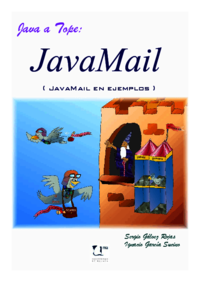
javaMail(en ejemplos)
113 Visitas | 137 Descargas | 2015-03-18 18:53:25 | adbenitez
este libro trata sobre como trabajar con la libreria javamail...una API muy util para el manejo de correos electronicos.....
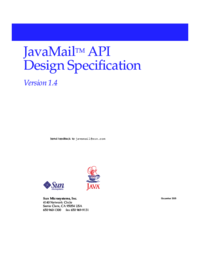
JAVAMail1.4
83 Visitas | 109 Descargas | 2015-03-18 18:55:44 | adbenitez
este libro nos da un recorrido por todas las clases de javaMail... como si fuese un javadoc....muy util para el conocimiento a fondo de las clases y metodos de esta API
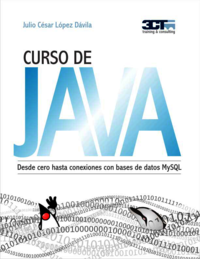
curso de java
203 Visitas | 306 Descargas | 2015-06-24 19:09:30 | jhdelgado
Este curso de Java trata de ser una guía paso a paso, desde cero, para crear una aplicación de escritorio que se conecte al servidor de MySQL; está dirigido a quienes dominan los fundamentos de programación en algún otro lenguaje, que además tienen los rudimentos de las consultas a las bases de datos relacionales. A lo largo del curso se usan diversas librerías de la Java Estandar Edition tales como java.lang, java.awt, javax.swing y java.sql de las que se estudian, ejemplifican y aplican las clases esenciales.

Lucene in Action
A guide to the Java search engine
75 Visitas | 121 Descargas | 2015-08-18 19:31:23 | alejandromorales
Lucene in Action delivers details, best practices, caveats, tips, and tricks for using the best open-source Java search engine available.
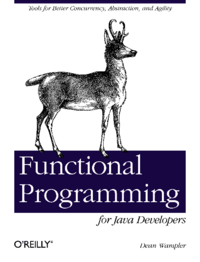
Functional Programming for Java Developers
Functional Programming for Java Developers
116 Visitas | 148 Descargas | 2015-11-02 15:24:52 | pecarrazana
Welcome to Functional Programming for Java Developers Why should a Java developer learn about functional programming (FP)? After all, hasn’t functional programming been safely hidden in academia for decades? Isn’t object-oriented programming (OOP) all we really need? This book explains why functional programming has become an important tool for the challenges of our time and how you, a Java developer, can use it to your advantage. The recent interest in functional programming started as a response to the growing pervasiveness of concurrency as a way of scaling horizontally, through parallelism. Multithreaded programming (see, e.g., [Goetz2006]) is difficult to do well and few developers are good at it. As we’ll see, functional programming offers better strategies for writing robust, concurrent software. An example of the greater need for horizontal scalability is the growth of massive data sets requiring management and analysis, the so-called big data trend. These are data sets that are too large for traditional database management systems. They require clusters of computers to store and process the data. Today, it’s not just Google, Yahoo!, Facebook, and Twitter who work with big data. Many organizations face this challenge. Once you learn the benefits of functional programming, you find that it improves all the code you write. When I learned functional programming a few years ago, it re-energized my enthusiasm for programming. I saw new, exciting ways to approach old problems. The rigor of functional programming complemented the design and testing benefits of test-driven development, giving me greater confidence in my work. I learned functional programming using the Scala programming language [Scala] and co-wrote a book on Scala with Alex Payne, called Programming Scala (O’Reilly). Scala is a JVM language, a potential successor to Java, with the goal of bringing object-oriented and functional programming into one coherent whole. Clojure is the other well-known functional language on the JVM. It is a Lisp dialect that minimizes the use of OOP in favor of functional programming. Clojure embodies a powerful vision for how pro- gramming should be done.

Griffon in Action
Griffon
53 Visitas | 92 Descargas | 2015-11-02 15:27:49 | pecarrazana
Griffon in Action is a comprehensive introduction to the Griffon framework that covers the basic building blocks such as MVC groups, binding, threading, services, plugins, and addons. But don’t let this quick summary fool you into thinking the topics are covered lightly. The book provides deep dives into the topics at hand, following a practical approach to get you started as quickly as possible. Who should read this book This book is for anyone interested in writing desktop applications for the Java virtual machine (JVM). Whether you’re a seasoned Java developer or just starting on your way, Griffon in Action will give you the knowledge to get started writing desktop applications in a productive manner and—why not?—have some fun while you’re at it. Some experience with Java Swing is assumed. Previous experience with Grails is an advantage, but we take the time to explain the crucial concepts where we think a common base should be explicitly stated. If you’re coming from another language background (such as Ruby or Python), you should find that using the Groovy language comes naturally.
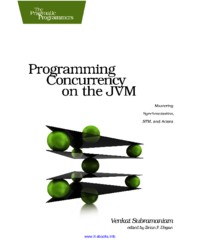
Programming Concurrency on the JVM
Programming Concurrency on the JVM
105 Visitas | 143 Descargas | 2015-11-02 15:31:18 | pecarrazana
I’ve written this book for experienced Java programmers who are interested in learning how to manage and make use of concurrency on the JVM, using languages such as Java, Clojure, Groovy, JRuby, and Scala. If you’re new to Java, this book will not help you learn the basics of Java. There are several good books that teach the fundamentals of Java programming, and you should make use of them. If you have fairly good programming experience on the JVM but find yourself needing material that will help further your practical understanding of programming concurrency, this book is for you. If you’re interested only in the solutions directly provided in Java and the JDK—Java threading and the concurrency library—I refer you to two very good books already on the market that focus on that: Brian Goetz’s Java Concurrency in Practice [Goe06] and Doug Lea’s Concurrent Programming in Java [Lea00]. Those two books provide a wealth of information on the Java Memory Model and how to ensure thread safety and consistency. My focus in this book is to help you use, but also move beyond, the solutions provided directly in the JDK to solve some practical concurrency problems. You will learn about some third-party Java libraries that help you work easily with isolated mutability. You will also learn to use libraries that reduce complexity and error by eliminating explicit locks. My goal in this book is to help you learn the set of tools and approaches that are available to you today so you can sensibly decide which one suits you the best to solve your immediate concurrency problems.
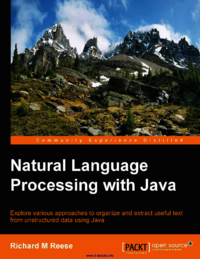
Natural Language Processing with Java
Natural Language Processing with Java
115 Visitas | 135 Descargas | 2015-11-19 21:04:23 | pecarrazana
What this book covers Chapter 1, Introduction to NLP, explains the importance and uses of NLP. The NLP techniques used in this chapter are explained with simple examples illustrating their use. Chapter 2, Finding Parts of Text, focuses primarily on tokenization. This is the first step in more advanced NLP tasks. Both core Java and Java NLP tokenization APIs are illustrated. Chapter 3, Finding Sentences, proves that sentence boundary disambiguation is an important NLP task. This step is a precursor for many other downstream NLP tasks where text elements should not be split across sentence boundaries. This includes ensuring that all phrases are in one sentence and supporting parts of speech analysis. Chapter 4, Finding People and Things, covers what is commonly referred to as Named Entity Recognition. This task is concerned with identifying people, places, and similar entities in text. This technique is a preliminary step for processing queries and searches. Chapter 5, Detecting Parts of Speech, shows you how to detect parts of speech, which are grammatical elements of text, such as nouns and verbs. Identifying these elements is a significant step in determining the meaning of text and detecting relationships within text. Chapter 6, Classifying Texts and Documents, proves that classifying text is useful for tasks such as spam detection and sentiment analysis. The NLP techniques that support this process are investigated and illustrated. Chapter 7, Using Parser to Extract Relationships, demonstrates parse trees. A parse tree is used for many purposes, including information extraction. It holds information regarding the relationships between these elements. An example implementing a simple query is presented to illustrate this process. Chapter 8, Combined Approaches, contains techniques for extracting data from various types of documents, such as PDF and Word files. This is followed by an examination of how the previous NLP techniques can be combined into a pipeline to solve larger problems.
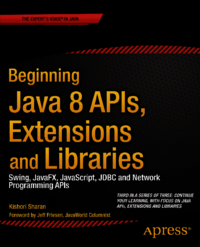
Beginning Java 8 APIs,Extensions and Extensions
Beginning Java 8 APIs,Extensions and Extensions
139 Visitas | 177 Descargas | 2016-09-15 16:10:19 | pecarrazana
This is the third book in the three-book Beginning Java series. This book contains 10 chapters. The chapters cover the Java libraries and extensions such as Swing, JavaFX, Nashorn, Java Native Interface, network programming, etc. If you have intermediate level Java experience, you can pick up chapters in any order. The new features of Java 8 are included wherever they fit in the chapter. The Nashorn script engine, which was added in Java 8, is covered in depth.
Contribuir
Usted puede contribuir con Libros UCLV, es importante para nosotros su aporte..
Contribuir